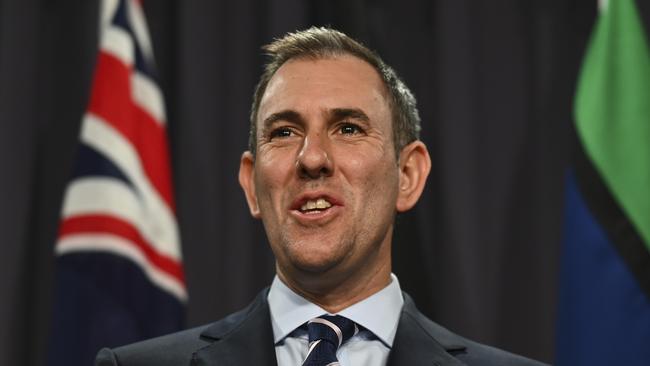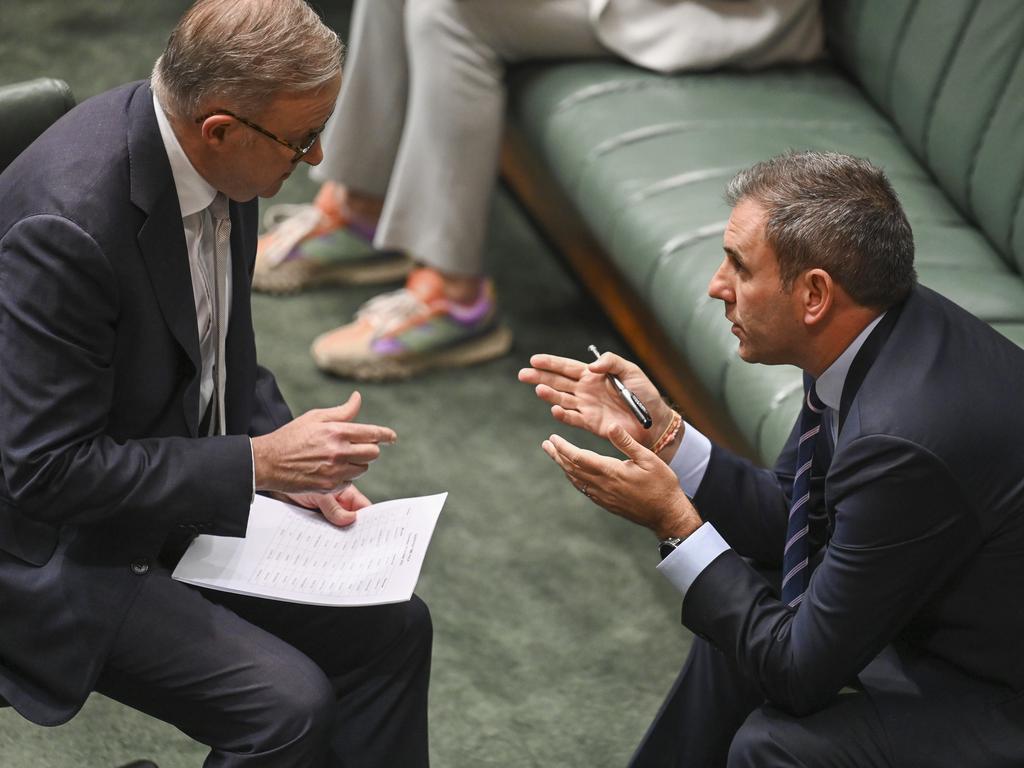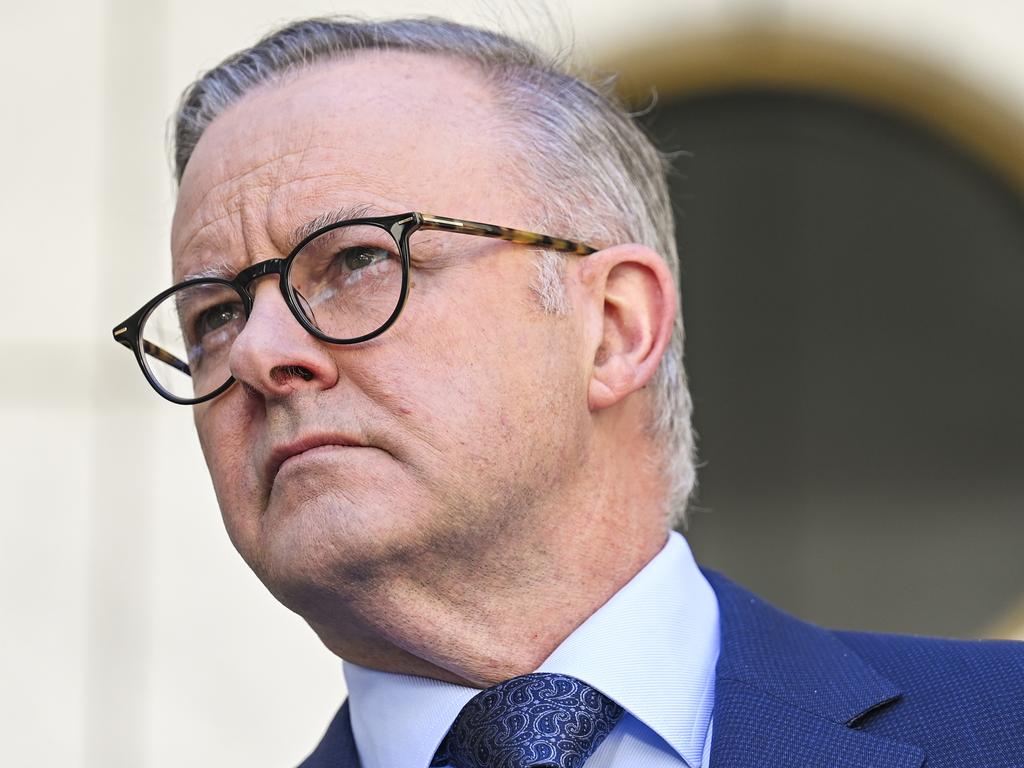2023 Outlook Conference: More government intervention needed to hit climate target, says Jim Chalmers
The Treasurer warns Australia cannot meet its net-zero emissions targets without more robust government intervention, paving the way for a new hands-on industry policy.

Jim Chalmers has warned Australia cannot meet its net-zero emissions targets without more robust interventions from government, paving the way for a new hands-on industry policy with bigger subsidies for companies helping fuel the green energy revolution.
In a landmark speech to the The Australian-Melbourne Institute Economic and Social Outlook conference on Thursday, the Treasurer said the Albanese government’s homegrown approach to cut greenhouse gases and become a “renewable energy superpower” would not mimic the gargantuan subsidies of US President Joe Biden’s game-changing Inflation Reduction Act, uncapped costs of which have grown to $US400bn ($635bn), but could almost treble.
But with energy analysts pouring doubt over Labor’s ability to reach its 82 per cent by 2030 renewables target, Dr Chalmers said that further action is needed for the government to meet its climate change targets.
He flagged a “uniquely Australian” revamp of industry policy to encourage an extra $225bn of investment in low-emissions technologies by 2050, including measures in the 2024-25 budget “to get private capital flowing towards our priorities effectively and efficiently”.
“We know further action is required to meet our targets, and ensure affordability, reliability and emissions reduction,” Dr Chalmers said.
“While important building blocks are now in place and progress has been made, we will need to do even more to secure sufficient renewable energy generation, transmission and storage to meet our ambitions.
“Without more decisive action, across all levels of government, working with investors, industry and communities, the energy transition could fall short of what the country needs.”
Dr Chalmers also released a new Treasury consultation paper outlining a proposed compulsory climate disclosure regime for businesses that will be standardised and bring Australia in line with global standards.
The paper will detail the commonwealth’s new “green bond” program as the government steps up efforts to encourage more investment into firms and projects that will propel the country towards its net-zero targets.
Anthony Albanese will address the Melbourne event, whose theme is “Bold ideas for a defining decade”, providing a midterm assessment of his government’s performance since winning office in May last year and an early taste of Labor’s policy priorities for a second-term agenda.
The Treasurer said: “The net-zero transformation will be the defining piece of the defining decade. Whether we succeed or fail in these ‘turbulent twenties’ will in large part be determined by how we maximise our advantages and leverage our strengths when it comes to energy in our economy. That’s why it’s such a major focus of the government.”
Labor’s supercharged industry subsidies will initially focus on four priority areas of green investment, based on the nation’s natural advantages: refining and processing critical minerals; supporting manufacturing of generation and storage technologies, including batteries; producing renewable hydrogen and its derivatives like ammonia, and; forging “green” metals.
“These are fundamental comparative advantages from which we can create new ones, in new industries, in new places across the country, leveraging our traditional strengths,” the Treasurer said. “Put simply, to meet our potential, to maximise our advantages in renewable energy and the economic and industrial opportunities that will come from them, we need to get more projects off the ground, faster.”
The Treasurer said the availability and magnitude of public and private capital required to reach emissions objectives is a prime focus, and critical, “with $225bn in additional investment required by 2050 across energy and industry, by some estimates”. But the flow of dollars is not the only issue. Also to be considered is whether:
• Australia can be competitive in the industry, by leveraging and building up our comparative advantages;
• it contributes to an efficient and orderly pathway to net zero;
• it builds the capabilities and resilience of people and regions.
• it improves national security and economic resilience and supports the strategic objectives of our global partners; and
• it recognises the key role of the private sector and delivers genuine value for money for government.
“We need a set of prescriptions right for this transformation and right for this country,” the Treasurer said. “We will complement, not copy, the priorities and plans of other nations, not just do exactly the same kind of investment with the exact same subsidies.
“We won’t realise Australia’s unique geographical, geological, geopolitical, intellectual and meteorological advantages by designing an inflation reduction act lite – looking only for big numbers but missing the bigger picture.
“Our plan will be ambitious, but uniquely Australian, focused on Australia’s strengths – on renewable energy, resources, our reputation as a trusted and reliable trading partner, on our people, and our knowledge.”
He said the Productivity Commission, under new chair Danielle Wood, “should and will play a bigger, more constructive role in organising our thinking when it comes to climate and energy policy”.
Dr Chalmers’ speech comes as the International Monetary Fund urged Canberra to continue its efforts to transition to net zero, even as it repeated that “an economy-wide carbon price would be the most effective way to achieve net zero”.







To join the conversation, please log in. Don't have an account? Register
Join the conversation, you are commenting as Logout